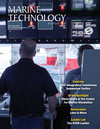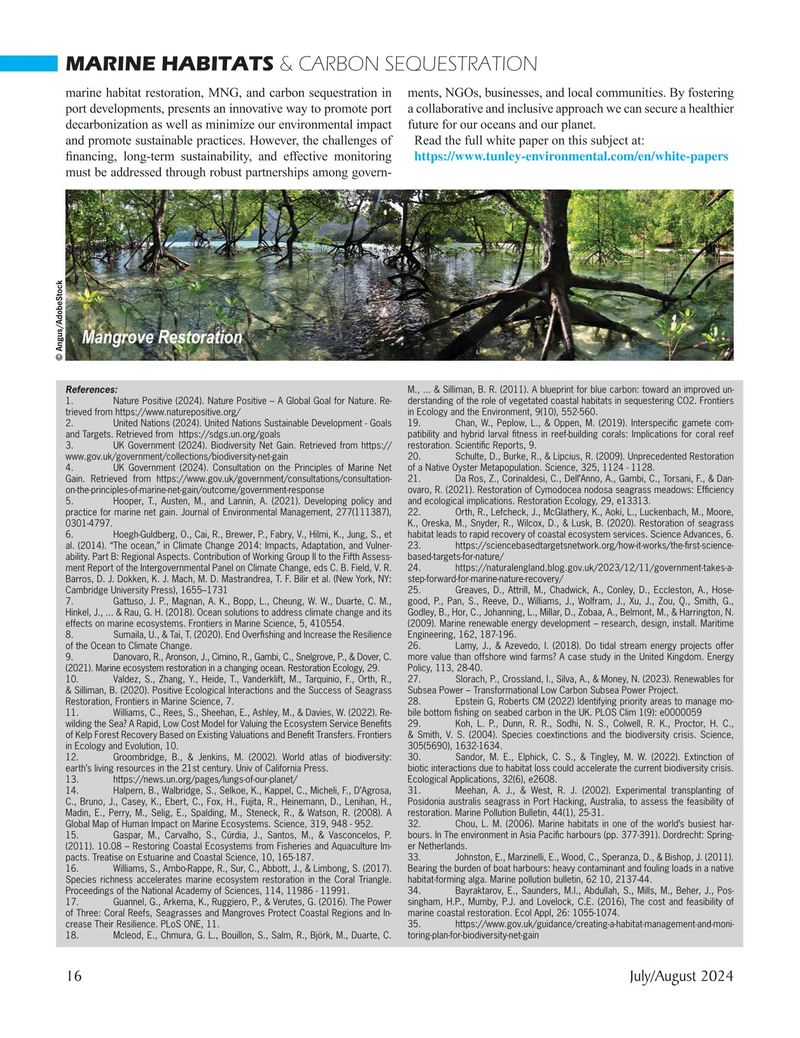
Page 16: of Marine Technology Magazine (July 2024)
Read this page in Pdf, Flash or Html5 edition of July 2024 Marine Technology Magazine
MARINE HABITATS & CARBON SEQUESTRATION marine habitat restoration, MNG, and carbon sequestration in ments, NGOs, businesses, and local communities. By fostering port developments, presents an innovative way to promote port a collaborative and inclusive approach we can secure a healthier decarbonization as well as minimize our environmental impact future for our oceans and our planet.
and promote sustainable practices. However, the challenges of Read the full white paper on this subject at: ? nancing, long-term sustainability, and effective monitoring https://www.tunley-environmental.com/en/white-papers must be addressed through robust partnerships among govern-
Mangrove Restoration © Angus/AdobeStock
References: M., ... & Silliman, B. R. (2011). A blueprint for blue carbon: toward an improved un- 1. Nature Positive (2024). Nature Positive – A Global Goal for Nature. Re- derstanding of the role of vegetated coastal habitats in sequestering CO2. Frontiers trieved from https://www.naturepositive.org/ in Ecology and the Environment, 9(10), 552-560.
2. United Nations (2024). United Nations Sustainable Development - Goals 19. Chan, W., Peplow, L., & Oppen, M. (2019). Interspeci? c gamete com- and Targets. Retrieved from https://sdgs.un.org/goals patibility and hybrid larval ? tness in reef-building corals: Implications for coral reef 3. UK Government (2024). Biodiversity Net Gain. Retrieved from https:// restoration. Scienti? c Reports, 9.
www.gov.uk/government/collections/biodiversity-net-gain 20. Schulte, D., Burke, R., & Lipcius, R. (2009). Unprecedented Restoration 4. UK Government (2024). Consultation on the Principles of Marine Net of a Native Oyster Metapopulation. Science, 325, 1124 - 1128.
Gain. Retrieved from https://www.gov.uk/government/consultations/consultation- 21. Da Ros, Z., Corinaldesi, C., Dell’Anno, A., Gambi, C., Torsani, F., & Dan- on-the-principles-of-marine-net-gain/outcome/government-response ovaro, R. (2021). Restoration of Cymodocea nodosa seagrass meadows: Ef? ciency 5. Hooper, T., Austen, M., and Lannin, A. (2021). Developing policy and and ecological implications. Restoration Ecology, 29, e13313.
practice for marine net gain. Journal of Environmental Management, 277(111387), 22. Orth, R., Lefcheck, J., McGlathery, K., Aoki, L., Luckenbach, M., Moore, 0301-4797. K., Oreska, M., Snyder, R., Wilcox, D., & Lusk, B. (2020). Restoration of seagrass 6. Hoegh-Guldberg, O., Cai, R., Brewer, P., Fabry, V., Hilmi, K., Jung, S., et habitat leads to rapid recovery of coastal ecosystem services. Science Advances, 6.
al. (2014). “The ocean,” in Climate Change 2014: Impacts, Adaptation, and Vulner- 23. https://sciencebasedtargetsnetwork.org/how-it-works/the-? rst-science- ability. Part B: Regional Aspects. Contribution of Working Group II to the Fifth Assess- based-targets-for-nature/ ment Report of the Intergovernmental Panel on Climate Change, eds C. B. Field, V. R. 24. https://naturalengland.blog.gov.uk/2023/12/11/government-takes-a-
Barros, D. J. Dokken, K. J. Mach, M. D. Mastrandrea, T. F. Bilir et al. (New York, NY: step-forward-for-marine-nature-recovery/
Cambridge University Press), 1655–1731 25. Greaves, D., Attrill, M., Chadwick, A., Conley, D., Eccleston, A., Hose- 7. Gattuso, J. P., Magnan, A. K., Bopp, L., Cheung, W. W., Duarte, C. M., good, P., Pan, S., Reeve, D., Williams, J., Wolfram, J., Xu, J., Zou, Q., Smith, G.,
Hinkel, J., ... & Rau, G. H. (2018). Ocean solutions to address climate change and its Godley, B., Hor, C., Johanning, L., Millar, D., Zobaa, A., Belmont, M., & Harrington, N. effects on marine ecosystems. Frontiers in Marine Science, 5, 410554. (2009). Marine renewable energy development – research, design, install. Maritime 8. Sumaila, U., & Tai, T. (2020). End Over? shing and Increase the Resilience Engineering, 162, 187-196.
of the Ocean to Climate Change. 26. Lamy, J., & Azevedo, I. (2018). Do tidal stream energy projects offer 9. Danovaro, R., Aronson, J., Cimino, R., Gambi, C., Snelgrove, P., & Dover, C. more value than offshore wind farms? A case study in the United Kingdom. Energy (2021). Marine ecosystem restoration in a changing ocean. Restoration Ecology, 29. Policy, 113, 28-40.
10. Valdez, S., Zhang, Y., Heide, T., Vanderklift, M., Tarquinio, F., Orth, R., 27. Slorach, P., Crossland, I., Silva, A., & Money, N. (2023). Renewables for & Silliman, B. (2020). Positive Ecological Interactions and the Success of Seagrass Subsea Power – Transformational Low Carbon Subsea Power Project.
Restoration, Frontiers in Marine Science, 7. 28. Epstein G, Roberts CM (2022) Identifying priority areas to manage mo- 11. Williams, C., Rees, S., Sheehan, E., Ashley, M., & Davies, W. (2022). Re- bile bottom ? shing on seabed carbon in the UK. PLOS Clim 1(9): e0000059 wilding the Sea? A Rapid, Low Cost Model for Valuing the Ecosystem Service Bene? ts 29. Koh, L. P., Dunn, R. R., Sodhi, N. S., Colwell, R. K., Proctor, H. C., of Kelp Forest Recovery Based on Existing Valuations and Bene? t Transfers. Frontiers & Smith, V. S. (2004). Species coextinctions and the biodiversity crisis. Science, in Ecology and Evolution, 10. 305(5690), 1632-1634.
12. Groombridge, B., & Jenkins, M. (2002). World atlas of biodiversity: 30. Sandor, M. E., Elphick, C. S., & Tingley, M. W. (2022). Extinction of earth’s living resources in the 21st century. Univ of California Press. biotic interactions due to habitat loss could accelerate the current biodiversity crisis. 13. https://news.un.org/pages/lungs-of-our-planet/ Ecological Applications, 32(6), e2608.
14. Halpern, B., Walbridge, S., Selkoe, K., Kappel, C., Micheli, F., D’Agrosa, 31. Meehan, A. J., & West, R. J. (2002). Experimental transplanting of
C., Bruno, J., Casey, K., Ebert, C., Fox, H., Fujita, R., Heinemann, D., Lenihan, H., Posidonia australis seagrass in Port Hacking, Australia, to assess the feasibility of
Madin, E., Perry, M., Selig, E., Spalding, M., Steneck, R., & Watson, R. (2008). A restoration. Marine Pollution Bulletin, 44(1), 25-31.
Global Map of Human Impact on Marine Ecosystems. Science, 319, 948 - 952. 32. Chou, L. M. (2006). Marine habitats in one of the world’s busiest har- 15. Gaspar, M., Carvalho, S., Cúrdia, J., Santos, M., & Vasconcelos, P. bours. In The environment in Asia Paci? c harbours (pp. 377-391). Dordrecht: Spring- (2011). 10.08 – Restoring Coastal Ecosystems from Fisheries and Aquaculture Im- er Netherlands.
pacts. Treatise on Estuarine and Coastal Science, 10, 165-187. 33. Johnston, E., Marzinelli, E., Wood, C., Speranza, D., & Bishop, J. (2011). 16. Williams, S., Ambo-Rappe, R., Sur, C., Abbott, J., & Limbong, S. (2017). Bearing the burden of boat harbours: heavy contaminant and fouling loads in a native
Species richness accelerates marine ecosystem restoration in the Coral Triangle. habitat-forming alga. Marine pollution bulletin, 62 10, 2137-44.
Proceedings of the National Academy of Sciences, 114, 11986 - 11991. 34. Bayraktarov, E., Saunders, M.I., Abdullah, S., Mills, M., Beher, J., Pos- 17. Guannel, G., Arkema, K., Ruggiero, P., & Verutes, G. (2016). The Power singham, H.P., Mumby, P.J. and Lovelock, C.E. (2016), The cost and feasibility of of Three: Coral Reefs, Seagrasses and Mangroves Protect Coastal Regions and In- marine coastal restoration. Ecol Appl, 26: 1055-1074.
crease Their Resilience. PLoS ONE, 11. 35. https://www.gov.uk/guidance/creating-a-habitat-management-and-moni- 18. Mcleod, E., Chmura, G. L., Bouillon, S., Salm, R., Björk, M., Duarte, C. toring-plan-for-biodiversity-net-gain 16 July/August 2024
MTR #5 (1-17).indd 16 7/23/2024 1:48:30 PM

 15
15

 17
17
